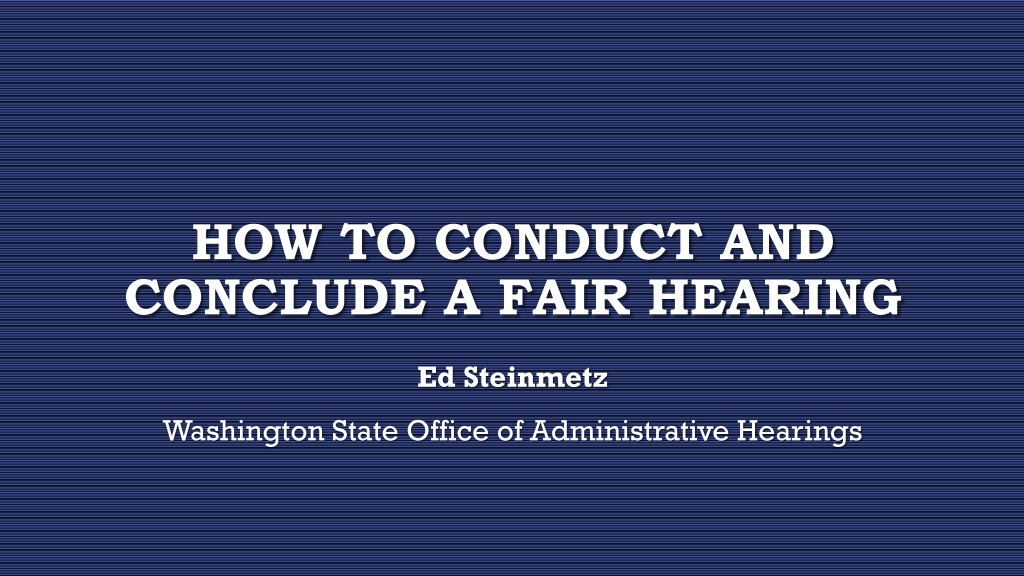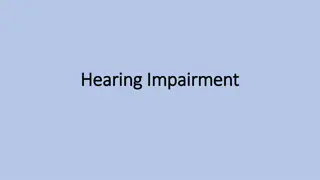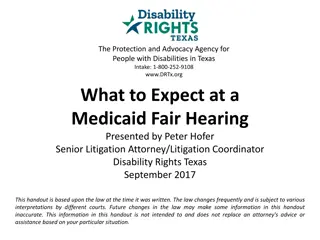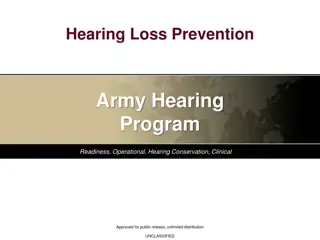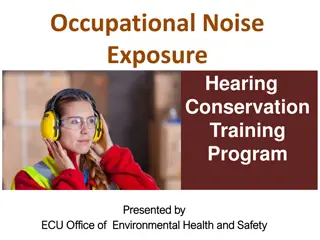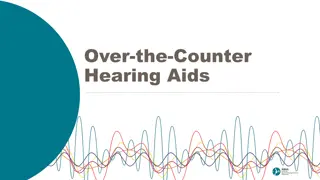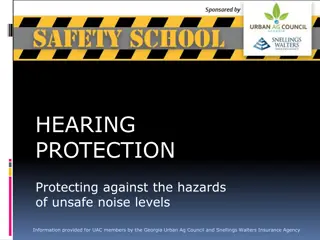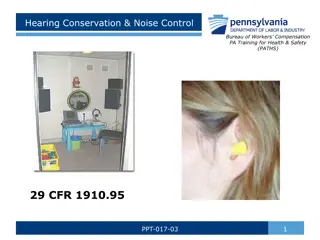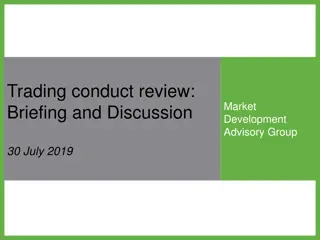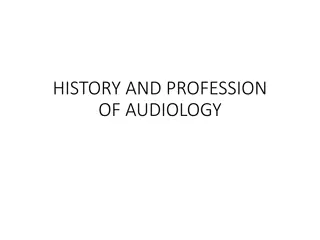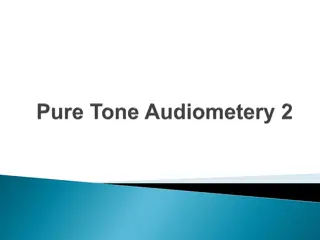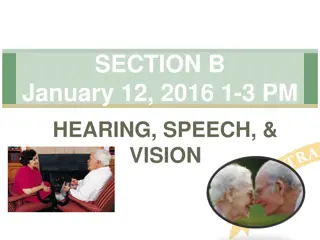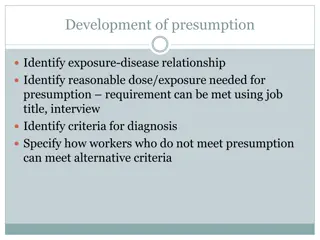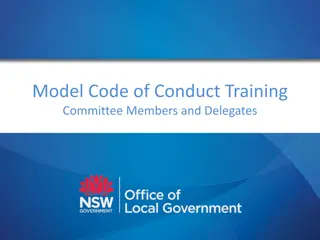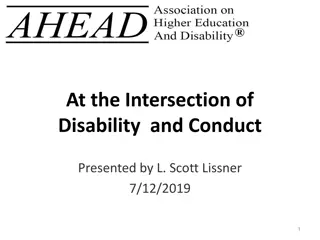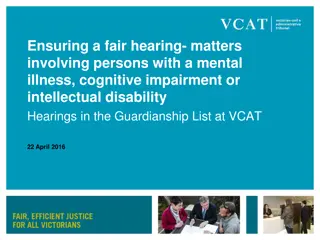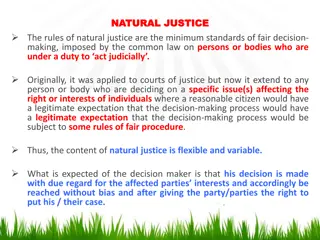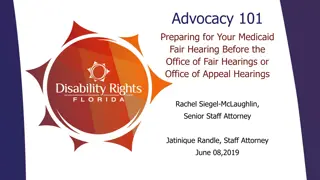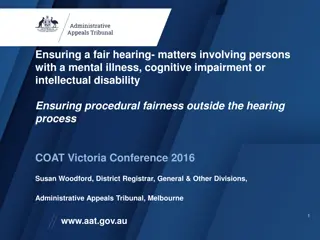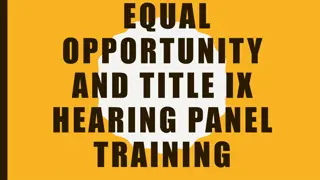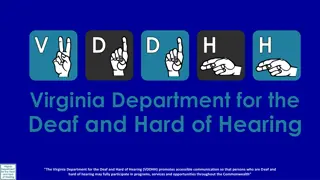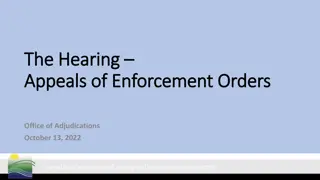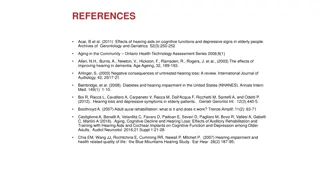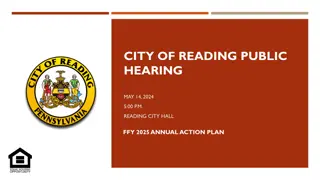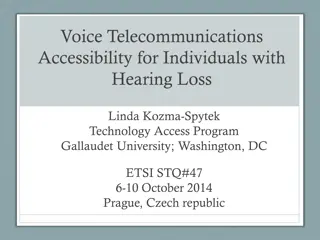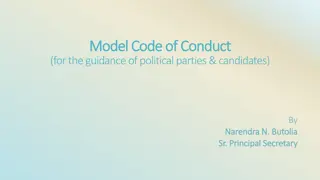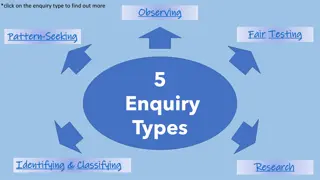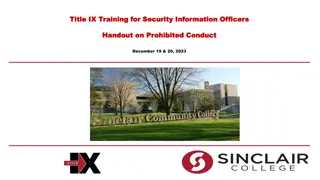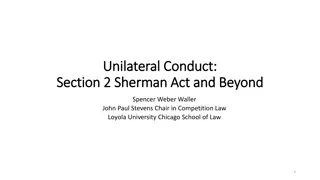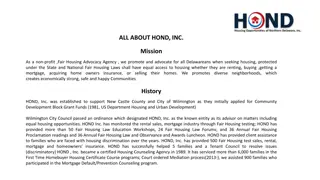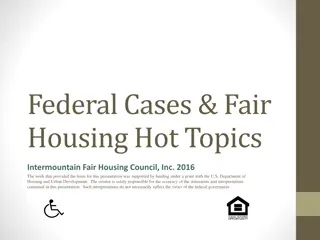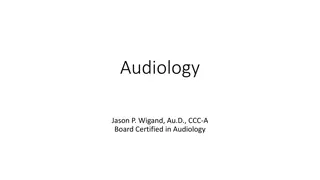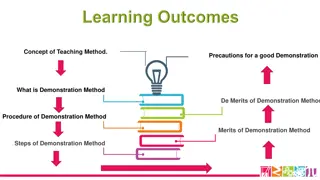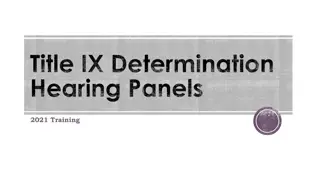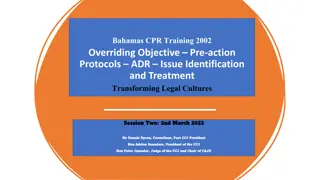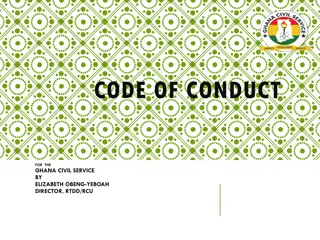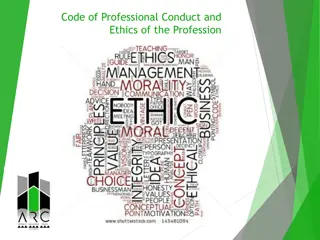How to Conduct and Conclude a Fair Hearing with Ed Steinmetz
A comprehensive guide on conducting a fair hearing, covering key steps such as prehearing explanations, opening statements, handling exhibits, managing witnesses, and ensuring orderly testimony from each witness. The guide emphasizes creating a level playing field, allowing parties to participate, and providing opportunities for questioning witnesses to build a complete record for a quality decision.
Download Presentation

Please find below an Image/Link to download the presentation.
The content on the website is provided AS IS for your information and personal use only. It may not be sold, licensed, or shared on other websites without obtaining consent from the author. Download presentation by click this link. If you encounter any issues during the download, it is possible that the publisher has removed the file from their server.
E N D
Presentation Transcript
HOW TO CONDUCT AND CONCLUDE A FAIR HEARING Ed Steinmetz Washington State Office of Administrative Hearings
PREHEARING/PRE-TESTIMONY EXPLANATION # 1 Intent is to ensure parties know how hearing will be conducted Explain rights and opportunities to participate in hearing Allow parties to ask questions about process and procedure, closing door on possible appeal
OPENING STATEMENT #2 Before taking testimony, orient parties and appellate listeners level the playing field Hearing Officer/ALJ should identify themselves, parties, witnesses and representatives present Date, time and place of hearing and confirm addresses The decision under appeal, issues to be discussed
EXHIBITS #3 US DOL Top Ten deficiency for 2017 Intent is to build as complete a record as possible Describe and mark all exhibits; provide opportunity to review exhibits and offer objections; rule on admissibility Jurisdictional vs. Substantive exhibits When hearing by telephone, confirm that all parties have received newly offered exhibits
WITNESSES #4 Parties to be sworn in on the record Testimony taken in logical and orderly manner Party carrying burden of proof should go first Witness with the most information should testify first Avoid bouncing back and forth between witnesses
ORDER OF TESTIMONY FROM EACH WITNESS #5 Move testimony of each witness to a conclusion in a logical and orderly manner Goal is to obtain relevant information under time constraints Sufficient detail pertaining to final incident to support quality decision
OPPORTUNITY TO QUESTION OWN WITNESS #6 US DOL Top Ten deficiency for 2017 Must provide parties a timely opportunity to ask questions of own witness(es) Timely means before Hearing Officer moves on to take testimony of another witness When necessary, ALJ may impartially assist a party in framing questions no leading
CLEAR LANGUAGE #7 Intent is to ensure that the hearing is clear and understandable Avoid unnecessary legal phrases and technical jargon in discussions during hearing If a party or witness appears to not understand, tactfully confirm whether person understands and rephrase questions or statements if necessary
SINGLE POINT QUESTIONS #8 Each question, whether asked by ALJ, party or representative, should express one point only Purpose is to ensure that both the question and the answer are understood clearly Questions should be in the form of who, what, when, where, how or why
CLARIFICATION OF STATEMENTS WHICH INCLUDE CONCLUSIONS #9 Intent to ensure that ALJ fulfills obligation to require witness to testify to evidentiary facts, as distinguished from conclusions Witness expressing opinions is subject to questioning to establish factual basis of opinion Expert testimony expressing opinions permitted if proper foundation laid regarding education, background, experience, training and field of study
*CONFRONTATION #10* Intent to ensure that parties are present and have the opportunity to see, hear and have knowledge of all evidence presented Problem areas include telephone hearings and exhibits sent to ALJ but not to other parties Properly qualified interpreter provides the right of confrontation to limited English proficiency or deaf parties
*CROSS-EXAMINATION #11* Cross-examination is a fundamental right Hearing Officer must advise parties of the right to cross-examine, and provide an opportunity to do so in a timely manner Timely means before moving on to take testimony of another witness Middle ground Fair score when cross-x not timely, but offered before conclusion of hearing
REPETITIVE AND/OR IRRELEVANT TESTIMONY #12 Hearing Officer should control repetitive or irrelevant testimony to keep hearing moving Ensure that answers given are responsive to questions asked Hearing Officer should give appropriate weight to unresponsive testimony, and advise witness of consequences of continued unresponsive or evasive testimony
LEADING QUESTIONS #13 US DOL Top Ten deficiency for 2017 A leading question is one that suggests the answer The ALJ should not ask improper leading questions on material issues, or allow others to do so Leading questions permitted to refresh witness memory as to dates, names, places etc. where not material, and where witness is hostile, biased or unwilling to cooperate
CONTROL OF INTERRUPTIONS #14 US DOL Top Ten deficiency for 2017 Hearing Officer must respond to interruptions of testimony and/or disruptive individuals Hearing Officer must also refrain from their own unnecessary interruptions Problem areas include telephone hearings where remote participants can be heard laughing, sighing or otherwise reacting to testimony
OFF THE RECORD #15 Intent is to build a record that is complete and without any unexplained interruptions Whether off the record event is planned or unplanned, once back on the record, ALJ should summarize the off the record event and obtain concurrence from parties that no off the record discussion of the case occurred
INTERPRETERS #16 Properly qualified interpreter provides the right of confrontation Hearing Officer must confirm interpreter s qualifications, administer the interpreter s oath, and require complete and literal interpretation of all statements and testimony to extent possible Hearing Officer, to the best of their ability should monitor conduct of interpreter
CONTINUANCES #17 Intent is to ensure timely disposition of cases and prompt payment to eligible individuals Criterion applies only to continuances and not to postponements If proper notice of hearing has been provided, a case should not be continued absent compelling or necessary reasons supported by the record
CLOSING THE HEARING #18 US DOL Top 10 Deficiency for 2017 Intent to ensure parties have full and fair opportunity to present their case Any wording by ALJ which clearly accomplishes this result is permissible, i.e. anything else? Helps close door on possible remand
*HEARING WITHIN SCOPE OF THE NOTICE #19* Intent is to ensure that hearing and decision are based upon issues to which parties received proper notice, or where parties willing to waive proper notice on the record For proper waiver, all parties must waive notice on the record Hearing Officer may decide to remand, but consider economy and efficiency to the parties
GRATUITOUS COMMENTS #20 ALJ should not interfere with the development of the case by making gratuitous comments or observations A gratuities comment is either unnecessary or improper, including comments on evidence, unless necessary to explore admissibility Generally, gratuitous comments do not include remarks intended to make the parties feel at ease
ATTITUDE #21 Hearing Officer should display an attitude that allows parties and reps. to speak freely, in an orderly manner, about the issues in the case Try to strike a balance between too formal and too informal Be careful to avoid a demeanor that projects an attitude of anger, dislike, impatience, frustration, distraction or lack of concern
*BIAS AND PREJUDICE #22* Appearance and substance for and against Intent is to ensure ALJ conducted the hearing in a fair and impartial manner Negative bias usually easy to spot. Not so easy with affinity or favoritism for. Problem area when Hearing Officer is performing affirmative duty to develop the record
OBTAIN REASONABLY AVAILABLE EVIDENCE #23 Intent to ensure Hearing Officer, while maintaining appearance of neutrality, functions as fact-finder, and makes sufficient efforts to obtain reasonably available evidence Reasonably available means evidence and testimony which is available at the hearing, and critical to issues to be decided Problem area is where a party has critical evidence, but didn t know to bring it to hearing
